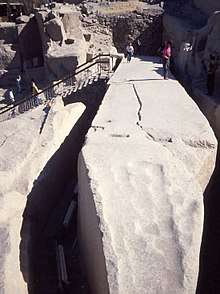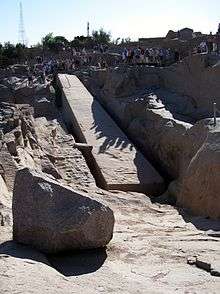Unfinished obelisk
Coordinates: 24°04′37″N 32°53′44″E / 24.076889°N 32.895450°E


The unfinished obelisk is the largest known ancient obelisk and is located in the northern region of the stone quarries of ancient Egypt in Aswan, Egypt.
History of the obelisk
Its creation was ordered by Hatshepsut (1508–1458 BC), possibly to complement what would later be known as the Lateran Obelisk (which was originally at Karnak, and was later brought to the Lateran Palace in Rome). The unfinished obelisk is nearly one-third larger than any ancient Egyptian obelisk ever erected. If finished it would have measured around 42 m (approximately 137 feet) and would have weighed nearly 1,090 metric tons (1,200 tons), a weight equal to about 200 African elephants.[1]
The obelisk's creators began to carve it directly out of bedrock, but cracks appeared in the granite and the project was abandoned. The bottom side of the obelisk is still attached to the bedrock.
The unfinished obelisk offers unusual insights into ancient Egyptian stone-working techniques, with marks from workers' tools still clearly visible as well as ocher-colored lines marking where they were working.
Besides the unfinished obelisk, an unfinished, partly worked obelisk base was discovered in 2005 at the quarries of Aswan.[2] Also discovered were some rock carvings and remains that may correspond to the site where most of the famous obelisks were worked. All these quarries in Aswan and the unfinished objects are an open-air museum and are officially protected by the Egyptian government as an archeological site.
Gallery
_(1904)_-_front_-_TIMEA.jpg) 1904 stereograph of the obelisk; note that unlike in modern images, the sand was not cleared away
1904 stereograph of the obelisk; note that unlike in modern images, the sand was not cleared away Obelisk quarry, detail
Obelisk quarry, detail View from the obelisk quarry
View from the obelisk quarry View from the obelisk quarry
View from the obelisk quarry Stone ball, possibly a chipping tool; see the outlined area
Stone ball, possibly a chipping tool; see the outlined area
See also
References
| Wikimedia Commons has media related to Unfinished obelisk in Aswan. |
- ↑ Bard, Kathryn (1999). Encyclopedia of the Archaeology of Ancient Egypt. Routledge. p. 587. ISBN 978-0-415-18589-9.
- ↑ "QuarryScapes". www.quarryscapes.no. Retrieved 2018-02-26.
